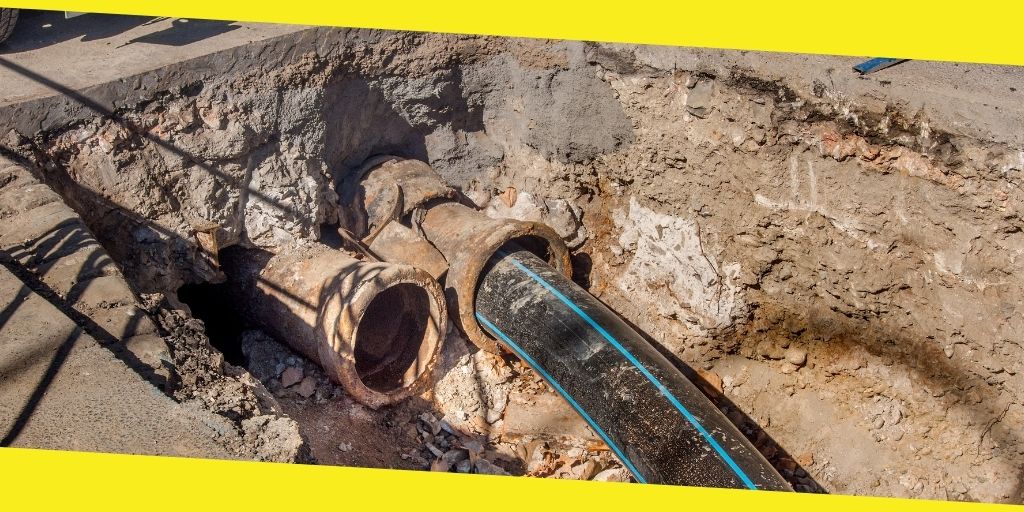Replacing an Old Sewer Line? How to Make It Easier
This post was last updated on July 16th, 2024

Many Canadians remain in their residences for much longer than used to be the norm. One reason for this is that the costs associated with renovating an existing home so that it’s more functional can oftentimes be less expensive than the costs associated with buying a new home. Those who do move often purchase residences that are between at least a quarter if a century old. The thing with buying an older residence is that there are more things to be on the lookout for – and one of them is your home’s main sewer line. If you’re not careful on this front, you may have to get a sewer line replacement sooner rather than later. This could be costly!
Why is it especially important to be mindful of the main sewer line in an older home? A main sewer line that is 25 years old or older is all but certainly constructed out of materials that, over time, are susceptible to leaking at the connection points. Modern pipes are made from plastic. They’re either glued together or assembled with fittings that provide robust protection against leaks. The same can’t be said for older pipes that were coated with cast iron, concrete, cement-asbestos, clay, and other materials that are nowhere near as watertight as newer pipes.
What Are the Reasons Behind Old Pipe Systems Malfunctioning?
No matter how well piping systems have been installed, they tend to shift over time. The constant cycle of rainy seasons, sub-zero temperatures, and warmer temperatures cause the ground around the buried pipe systems to move by small increments. Older systems that shift around tend to leak around the fittings area. If a leak occurs, more problems can materialize. For instance, water can trickle down beneath the pipe, cause more shifting, result in more leaking, and possibly come into contact with the root systems of trees. If roots discover the water source caused by the leaking, they will push against the connection points and, as the root system gets bigger over time, make the leaking problem worse.
It is true that there are ways to get rid of the roots – such as by removing or destroying the roots – but this will not address the leaking problem. The leaking will continue and get worse the longer it is left unfixed.
What Can I Do to Find Out Sewer Pipe Condition?
If you want to assess the condition of your sewer pipe, you need a sewer camera. A skilled plumbing professional will be able to use this specialized piece of equipment to check out your entire sewer pipe. The reason you’ll want to have a licensed professional do the work is that they will know how to perform the task properly. For instance, it’s important to first clean out the line so that there’s nothing to obstruct the camera as it scans the stretch of sewer pipe beginning at your home and going out to the sewer main beyond your property. When you do your research and find a reputable plumbing company, you will get both a full report on the state of your sewer line. You can expect to pay between $300 and $500 for the camera inspection.
What Solution is Best for You?
That depends. If the issue is situated in a small area, your best bet is to dig up the area in question and to fix the damaged pipe. After the plumbing company digs up the area and investigates the problem, they will look to see if there has been any root penetration. If this type of problem involves an older sewer line, the only viable solution may be a sewer drain replacement. The 3 permanent solutions to fix this problem include the following:
- Excavate the area and replace the damaged pipe.
- Used a pipe-bursting method to put in a new pipe.
- Leave the old pipe in place – but put a new liner within the old pipe.
Should You Trench and Replace?
One of the reasons many homeowners prefer to avoid trenching is that the process, while effective, is also invasive. It involves excavating a section of their property to get to the damaged pipe. You can contact ADP Group for Environmental Drilling and excavation services. But it’s sometimes the only viable option to remedy a pipe that has catastrophic damage. On the one hand, trenching and replacing is traditionally considered to be the most cost-effective way to do a sewer drain replacement. On the other hand, the costs associated with restoring landscaping, sidewalks, walkways, and driveways mean that trenching and replacing may actually end up being the costliest sewer drain replacement method.
Replacing Pipe Courtesy of the Bursting Method
The pipe-bursting method, which is used to replace pipes buried underground, is one of the earliest trenchless methods. The following steps are required to properly execute this method:
- A professional plumbing team creates an access hole on both ends of the pipe that needs to be replaced.
- A wire cable is threaded through the pipe from top to bottom.
- One of the ends of the pipe is attached to a pulling tool while the other end is attached to something called a bursting head.
- The new pipe, which will replace the damaged pipe, is connected to the bursting head.
- As the bursting head is pulled up the pipe, it demolishes and removes the old pipe so that the new pipe being pulled along takes the place of the damaged pipe.
While this is an effective solution, there are some drawbacks. One of them is that plumbing professionals are unable to determine what’s inside the damaged pipe. It is this issue that has prompted various municipalities to ban pipe-bursting as a sewer drain replacement method.
New Liner Installation
What should you do if the sewer line pipe is damaged – but not so much so that it must be replaced entirely? The preferred option in cases where the existing pipe is still in decent structural shape is to insert a new liner into it. These are the steps that are taken:
- The pipe that will receive the pipe liner is cleaned up and inspected using a sewer camera to ascertain whether or not the pipe can safely be lined.
- The professional plumber creates a hole on one end of the damaged pipe that will get the pipe liner. This makes it easier to get the pipe liner into the pipe. And the professional plumber measures the length of the pipe so that he can find out how long the liner needs to be.
- Pressurized air is used to insert the liner into the damaged pipe.
- The professional plumber inserts an inflatable device, like a balloon, into the liner. It is filled with air so as to expand the liner and to press it against the walls of the old piping. Once the balloon is taken out, the old pipe is left with a robust inner lining.
Whichever of these methods you opt for when pursuing sewer drain replacement, you will want to see the professional plumber’s warranty. The duration of the warranty should be at least 25 years, though there are some companies that will offer much longer warranties. Comb over it to ensure you know what the warranty offers. You should also do some research to ensure you find the right plumbing company to work with.
It’s important to realize that many municipalities are requiring homeowners to do more when it comes to their main sewer pipes. For instance, some municipalities mandate that main sewer pipes need to be inspected by a camera before homes can be sold. These municipalities are also requiring homeowners to maintain more of the sewer line system – not just on their property but beyond their property boundaries. So there are many good reasons to invest in routine sewer line inspections. Failing to do this might require you to get a sewer drain replacement sooner than you might otherwise have to.
You may like this
Recommended For You
What Are the Pros and Cons of Buying a Used Piano?
Most Inside
Most Inside offers high-quality recommendations and valuable updates to enhance all aspects of your life, providing premium guidance and enriching experiences.




